In 1935 Albert Einstein and collaborators Boris Podolski and Nathan Rosen (EPR) wrote a celebrated paper on "entangled states": systems that, according to quantum mechanics, must be treated as a single unit even if their pieces are far apart. They concluded that quantum mechanics cannot be a complete theory; this suggests that additional quantities ("hidden variables") are required to describe reality. Further theoretical and extensive experimental work for the last seven decades has ruled out most simple versions of the hidden variable idea and suggests that quantum mechanical entanglement is a feature of the world.
Previous experimental tests of quantum mechanics have been carried out with optical energy photons, systems of atoms and kaons (particles containing strange quarks). Using pairs of B mesons (particles containing b quarks) the Belle experiment at KEK in Tsukuba, Japan has submitted a paper to Physical Review Letters, a leading US physics journal, which reports tests of quantum mechanics at the 10 billion electron-volt energy scale, which is significantly beyond the energy scale of previous tests.
Belle tests quantum mechanics by measuring the time dependence of decays of B mesons that are produced from the decays of the Upsilon(4S) resonance at the KEKB electron-positron collider. The decay products are reconstructed in the Belle detector. By closely examining the time dependence of pairs of B meson decays, the Belle experimenters conclusively rule out two alternatives to quantum mechanics; spontaneous disentanglement in which the two B mesons evolve independently and another alternative called the Pompili-Selleri model.
The Belle results are consistent with the prediction of quantum mechanics, where each pair of B-mesons behaves as a single "entangled" object. The data have now been placed on public record, and can be used to test any other alternative models that are devised by theorists in the future.
The Belle experiment is a collaborative effort of scientists from universities and laboratories in America, Asia, Australia, and Europe. The experiment operates at the KEK High Energy Physics Laboratory in Tsukuba, Japan, which is home to the world's highest luminosity particle accelerator.
[ Media Contact ] Youhei Morita, KEK Public Relations Office
+81 29-879-6047
|
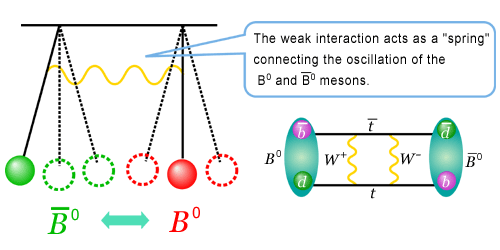 |
Figure 1 : A B-meson and an anti-B-meson ( ) change into each other. The probability of observing one type of meson oscillates as a function of time. This phenomenon is called ) change into each other. The probability of observing one type of meson oscillates as a function of time. This phenomenon is called  oscillation. oscillation.
|
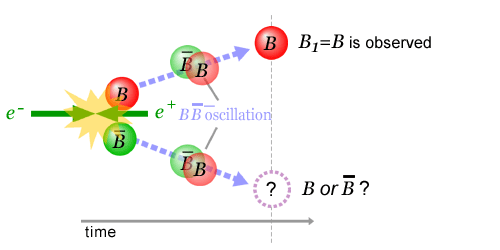 |
Figure 2 : At the KEK B-factory, a B-meson and anti-B-meson are generated as a pair. In a simple model of this process, each meson then oscillates independently between B and anti-B. If this were true, a distinctive pattern of results would be seen: sometimes B and B, sometimes B and anti-B, and so on.
|
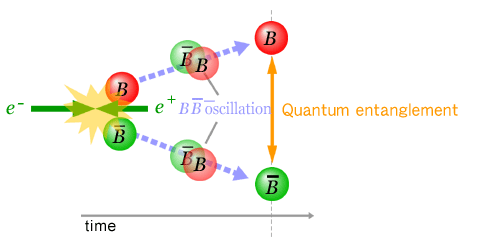 |
But according to quantum mechanics, the two mesons are "entangled" to form a single object. The first meson is seen as a B 50% of the time, and a anti-B 50% of the time. The second meson is in the opposite state, and then oscillates between B and anti-B as time passes. The pattern of results (B and B, B and anti-B, ...) is different from the simple model. Another model (the Pompili-Selleri model) avoids entanglement, and can produce results close to the quantum mechanical prediction, but is different in detail.
|
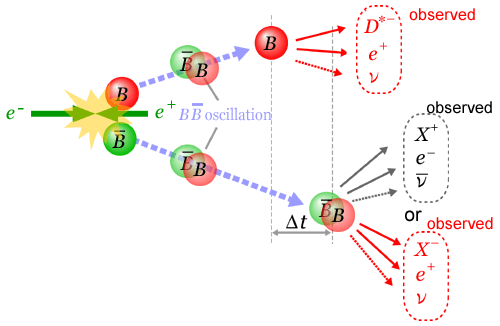 |
In this measurement, the Belle group selected the decay of one B-meson into a D* meson, a lepton (electron or muon), and a neutrino. The other particle may be either a B-meson or an anti-B-meson: by observing the remaining final state particles, the two can be distinguished. The time difference (Δ t) of the two mesons can be determined by the precise measurement of the decay points.
|
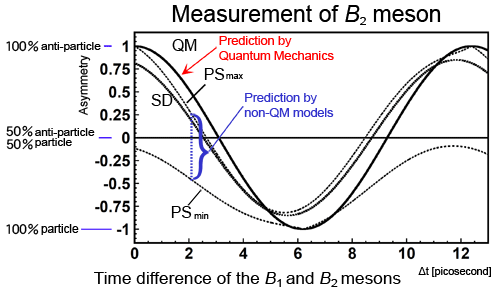 |
The simple model (SD, for "spontaneous disentanglement") predicts a pattern of decays different from those of quantum mechanics. The Pompili-Selleri model (PS) allows results closer to quantum mechanics, but not quite the same.
|
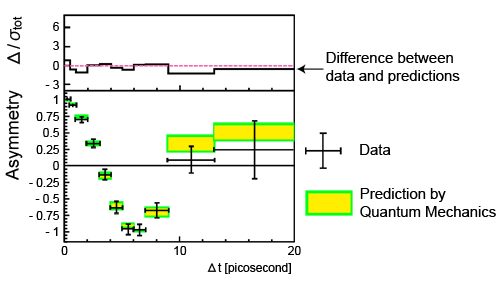 |
Figure 4 : The measurement of the B meson system by the Belle experiment is in good agreement with the prediction from Quantum Mechanics, and excludes the other models of interpretation.
|
|



